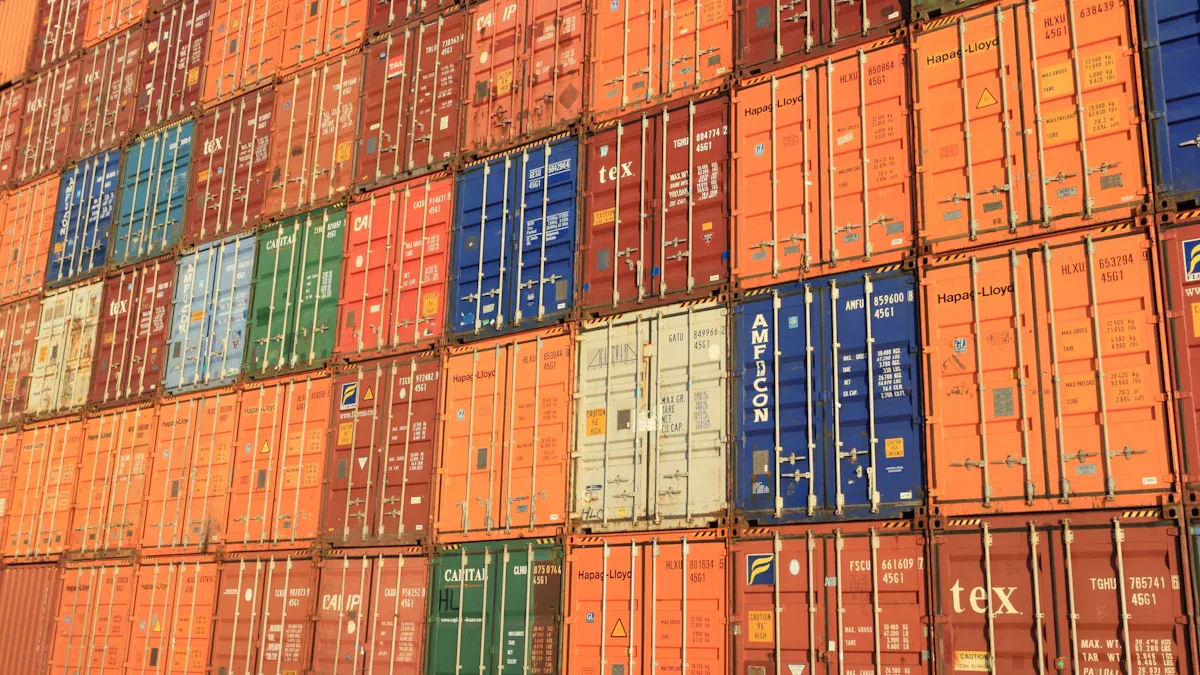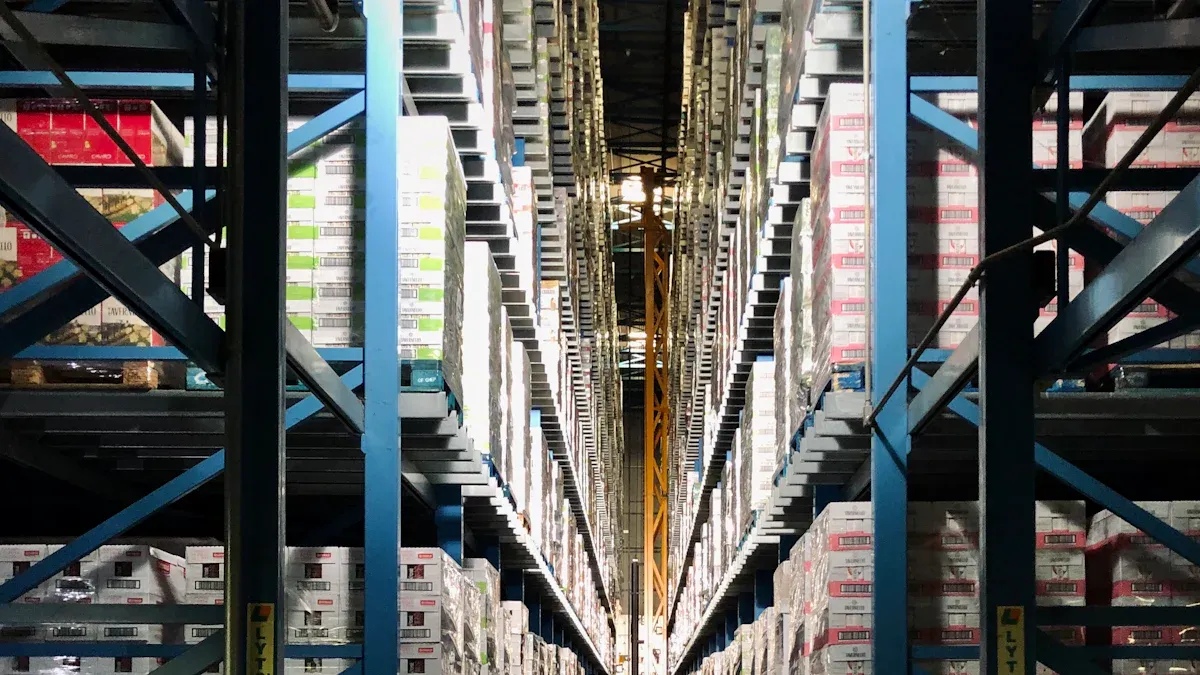How to Enhance Cross-Border E-Commerce Logistics Efficiency

Enhancing cross-border e-commerce logistics efficiency is crucial in modern trade, as it helps reduce operational costs, accelerate delivery times, and improve the customer experience. The global cross-border e-commerce logistics market, valued at USD 97.85 billion in 2023, is expected to reach USD 119.29 billion in 2024, with a CAGR of 25.4% through 2030. Transportation remains the dominant segment in this sector, accounting for 70% of the market share. Businesses that focus on enhancing cross-border e-commerce logistics efficiency by leveraging technology and optimizing processes report significant operational cost savings and streamlined logistics operations. These advancements are vital for meeting consumer expectations and driving e-commerce success.
Leveraging Technology to Optimize Cross-Border E-Commerce Logistics

Real-Time Tracking with Platforms like JusLink
Real-time tracking has revolutionized cross-border e-commerce logistics by enhancing operational transparency and efficiency. Platforms like JusLink empower businesses to monitor global inventory and track goods in transit with precision. This capability allows proactive management of purchase orders and helps identify potential risks before they escalate. For instance, JusLink provides immediate updates on delivery statuses and exceptions, ensuring all stakeholders remain informed throughout the shipping process. This fosters seamless collaboration with suppliers and enhances customer satisfaction by reducing uncertainties in cross-border operations.
The benefits of real-time tracking extend beyond visibility. Businesses can optimize their supply chains by addressing delays promptly and improving delivery accuracy. As the cross-border e-commerce market grows, adopting such technology becomes essential for maintaining a competitive edge.
AI and Data Analytics for Route Optimization
Artificial intelligence (AI) and data analytics play a pivotal role in optimizing cross-border logistics. These technologies analyze vast datasets to identify the most efficient delivery routes, reducing transit times and costs. Companies like UPS have demonstrated the power of AI-driven route optimization. By utilizing tools like ORION, UPS cut 100 million miles from their delivery routes, significantly lowering fuel consumption and operational expenses.
Other success stories include Swift Logistics, which achieved a 20% reduction in fuel consumption and a 30% improvement in delivery times through AI-driven solutions. Similarly, Express Fulfillment reduced transportation costs by 25% and improved on-time delivery rates by 40%. These examples highlight how AI and data analytics enhance cross-border e-commerce logistics by streamlining operations and improving service quality.
Automating Documentation and Customs Processes
Automation simplifies the complexities of cross-border e-commerce by streamlining documentation and customs procedures. Automated systems reduce manual labor, minimize errors, and accelerate processing times. For example, Workbox’s automation technology cuts documentation processing time by up to 80%, while automated document parsing processes 15,000 documents monthly at a fraction of the cost.
The advantages of automation extend to compliance and risk management. Businesses can adapt quickly to changes in trade laws and tariffs, ensuring adherence to regulatory standards. The table below summarizes key improvements achieved through automation:
Improvement Type | Description |
|---|---|
Streamlined Customs Declarations | Shortens processing times and ensures accuracy in customs declarations. |
Enhanced Logistics Efficiency | Minimizes shipping delays by reducing document processing time. |
Faster Import/Export Documentation | Expedites operations, accelerating clearing processes. |
Effective Compliance Management | Simplifies adherence to regulatory standards through automated data capture. |
By automating these processes, businesses can enhance cross-border e-commerce efficiency, reduce costs, and improve overall operational performance.
Warehouse Management Systems for Inventory Efficiency
Efficient inventory management is a cornerstone of successful cross-border e-commerce logistics. Warehouse Management Systems (WMS) play a pivotal role in streamlining inventory operations, ensuring accuracy, and reducing costs. These systems provide businesses with the tools to monitor stock levels, optimize storage, and improve order fulfillment processes.
A robust WMS offers several key benefits:
Real-Time Inventory Tracking: Businesses can track inventory levels across multiple warehouses, ensuring accurate stock availability.
Optimized Storage Utilization: WMS analyzes storage layouts to maximize space efficiency and reduce operational costs.
Improved Order Accuracy: Automated picking and packing processes minimize errors, enhancing customer satisfaction.
Faster Turnaround Times: Streamlined workflows enable quicker order processing and shipping.
Tip: Integrating WMS with platforms like JusLink enhances visibility across the supply chain, enabling seamless coordination between warehouses and transportation networks.
For example, JUSDA’s cloud warehousing solutions leverage advanced WMS technology to provide real-time inventory insights. These systems integrate IoT and big data analytics to predict demand, manage stock replenishment, and prevent overstocking or stockouts. Businesses using JUSDA’s solutions report significant improvements in operational efficiency and cost savings.
The table below highlights the impact of WMS on inventory efficiency:
Key Metric | Before WMS | After WMS Implementation |
|---|---|---|
Inventory Accuracy | 70-80% | 95-99% |
Order Fulfillment Time | 2-3 days | Same-day or next-day |
Storage Space Utilization | 60-70% | 85-95% |
Warehouse Management Systems empower businesses to meet the demands of cross-border e-commerce. By automating inventory processes and providing actionable insights, WMS ensures that companies can deliver products efficiently and maintain a competitive edge in the global market.
Integrating with Technology Providers like JUSDA
Integrating with technology providers like JUSDA is a transformative strategy for enhancing cross-border ecommerce logistics. JUSDA’s advanced solutions, such as the JusLink Smart Supply Chain platform, utilize IoT, cloud computing, and big data analytics to improve connectivity and information sharing. These technologies enable businesses to optimize resource allocation, streamline production processes, and enhance fulfillment efficiency.
JUSDA’s tailored solutions cater to diverse industries, including electronics and automotive, ensuring that businesses meet evolving consumer demands. By embracing Industry 4.0 principles, JUSDA integrates multimodal transport networks and advanced warehouse management systems, driving productivity and reducing operational costs.
Strategic partnerships with technology providers empower businesses to stay competitive in the dynamic cross-border ecommerce landscape. These collaborations enhance logistics efficiency, improve customer satisfaction, and support long-term growth.
Establishing Relationships with Regional Carriers
Establishing relationships with regional carriers is a critical strategy for enhancing cross-border e-commerce logistics. Regional carriers possess in-depth knowledge of local markets, enabling businesses to navigate complex delivery networks and ensure timely shipments. These carriers often have established infrastructure and expertise in handling last-mile delivery, which is essential for meeting customer expectations in diverse regions.
Strong partnerships with regional carriers provide several advantages. Businesses gain access to localized delivery networks, reducing transit times and improving delivery accuracy. Regional carriers also help mitigate risks associated with unfamiliar customs regulations and transportation challenges. For example, companies operating in Southeast Asia often rely on regional carriers to overcome infrastructure limitations and ensure seamless delivery.
The benefits of such partnerships are evident in real-world examples. The table below highlights how leading companies have leveraged regional carriers to optimize their cross-border logistics:
Company | Strategy | Benefits |
|---|---|---|
Ford Motor Company | Optimized supply chain with nearshoring and technology tracking | Seamless movement of parts and vehicles across borders |
Coca-Cola | Close collaboration with local suppliers and distributors | Compliance with regulations, minimized customs delays |
Patagonia | Nearshoring manufacturing to Mexico and collaboration with local partners | Reduced transportation times and costs, enhanced supply chain efficiency |
Hydro Flask | Partnered with a 3PL for cross-border e-commerce | Navigated customs complexities, ensured timely delivery to customers |
These examples demonstrate the transformative impact of regional carrier partnerships on cross-border logistics. Companies like Patagonia have successfully reduced transportation costs and improved supply chain efficiency by collaborating with local partners. Similarly, Hydro Flask has ensured timely deliveries by leveraging the expertise of third-party logistics providers.
To maximize the benefits of these partnerships, businesses should evaluate the capabilities of regional carriers and align their logistics strategies accordingly. By fostering strong relationships with these carriers, companies can enhance their operational efficiency, reduce costs, and deliver superior customer experiences in the competitive cross-border e-commerce market.
Optimizing Shipping and Delivery with JUSDASR

Choosing the Right Shipping Methods for Each Market
Selecting appropriate shipping methods is a critical strategy for cross-border ecommerce success. Different international markets have unique requirements regarding delivery speed, cost, and carrier preferences. For instance, customers in developed regions often prioritize faster delivery, while emerging markets may favor cost-effective options. Businesses must also comply with country-specific shipping regulations to avoid delays and penalties.
JUSDASR simplifies this process by offering tailored solutions for diverse markets. Its strategic partnerships with major carriers like FedEx and UPS ensure businesses can balance cost and speed effectively. By leveraging JUSDASR’s expertise, companies can align their shipping strategies with customer expectations and product types, ensuring seamless cross-border logistics operations.
Tip: Businesses should regularly evaluate market trends and customer feedback to refine their shipping strategies and maintain a competitive edge.
Consolidating Shipments to Reduce Costs
Consolidating shipments is an effective strategy to optimize shipping and logistics expenses in cross-border ecommerce. By grouping multiple orders into a single shipment, businesses can reduce transportation costs and improve efficiency. This approach minimizes the number of trips required, leading to lower fuel consumption and reduced carbon emissions.
JUSDASR excels in shipment consolidation through its strategically located warehouses across the United States. These facilities enable businesses to store inventory closer to key markets, facilitating faster and more cost-effective distribution. Additionally, JUSDASR’s advanced warehouse management systems streamline the consolidation process, ensuring timely and accurate deliveries.
Key benefits of shipment consolidation include:
Lower transportation costs due to fewer shipments.
Reduced customs clearance fees through bulk processing.
Enhanced delivery efficiency and environmental sustainability.
Using Data Analytics for Route Optimization
Data analytics plays a pivotal role in optimizing cross-border ecommerce logistics. Advanced analytics tools analyze traffic patterns, vehicle capacities, and delivery schedules to identify the most efficient routes. This reduces transit times, lowers fuel consumption, and enhances delivery accuracy.
JUSDASR leverages predictive analytics and real-time data monitoring to optimize shipping routes. For example, dynamic route planning adjusts delivery paths based on current conditions, ensuring timely shipments. The table below highlights key methods used in route optimization:
Method/Example | Description |
|---|---|
Distance Optimization | Identifies shortest routes while considering road blockages and traffic. |
Traffic Pattern Analysis | Suggests alternative routes during peak hours to avoid delays. |
Dynamic Route Planning | Adjusts routes in real-time for maximum efficiency. |
Vehicle Capacity Matching | Matches vehicle type with package volume for cost-effective deliveries. |
Historical Data Analysis | Provides insights into past performance for informed decision-making. |
By integrating these strategies, JUSDASR ensures businesses achieve measurable improvements in logistics performance. For instance, enhanced on-time delivery rates and reduced operational costs directly contribute to higher customer satisfaction and retention.
Offering Multiple Delivery Options for Customers
Offering multiple delivery options has become a cornerstone of customer satisfaction in cross-border e-commerce. Consumers value flexibility and convenience when selecting shipping methods, making it essential for businesses to cater to diverse preferences. By providing a range of delivery choices, companies can enhance the shopping experience and drive customer loyalty.
A study highlights that 74% of customers prefer having multiple delivery options, while 34% are more likely to complete a purchase when such options are available. The table below illustrates key customer feedback statistics:
Statistic | Percentage |
|---|---|
Prefer speed | 32% |
Prefer lower cost | 68% |
More likely to complete purchase with options | 34% |
Want multiple options | 74% |
Good delivery experience leads to repeat buys | 72% |

Businesses can implement strategies to meet these expectations effectively. For instance:
Flexible Delivery Options: Allow customers to choose between standard, express, or same-day shipping.
Out-of-Home Delivery: Offer pick-up points or locker services, as 55% of customers prefer avoiding home delivery.
Scheduled Deliveries: Enable customers to select specific dates and times, addressing the preferences of 45% of buyers.
JUSDASR excels in offering tailored shipping solutions. Its partnerships with major carriers like FedEx and UPS ensure reliable delivery options, catering to both cost-conscious and speed-focused customers. By leveraging JUSDASR’s expertise, businesses can align their logistics strategies with customer demands, enhancing satisfaction and retention.
Note: A good delivery experience not only satisfies customers but also encourages repeat purchases, as evidenced by 72% of buyers returning after a positive experience.
Enhancing cross-border e-commerce logistics efficiency is essential for businesses aiming to thrive in the global market. Leveraging technology, forming strategic partnerships, and optimizing processes empower companies to meet customer expectations while reducing costs. For instance, integrated platforms streamline logistics operations, improve traceability, and enhance customer satisfaction. Additionally, partnerships with local providers and customs brokers optimize resource allocation and foster innovation.
JUSDA and its specialized service, JUSDASR, play a pivotal role in addressing global logistics challenges. Their advanced solutions, such as JusLink and strategic warehousing, enable businesses to navigate complex supply chains with ease. By adopting these strategies, companies can ensure timely deliveries, improve operational efficiency, and build trust with their customers. Businesses that prioritize these approaches position themselves for long-term success in the competitive cross-border e-commerce landscape.
Note: With 90% of consumers expecting two-to-three day delivery, adopting efficient logistics strategies is no longer optional but a necessity.
See Also
Exploring Supplier Connections in Global E-commerce Strategies
Addressing Global Supply Chain Growth Issues Effectively
Enhancing Global E-commerce Through Supply Chain Transparency
Maximizing Supply Chain Efficiency: Expert Logistics Insights
Achieving Cross-Border Trade Success Through JUSDA Solutions
